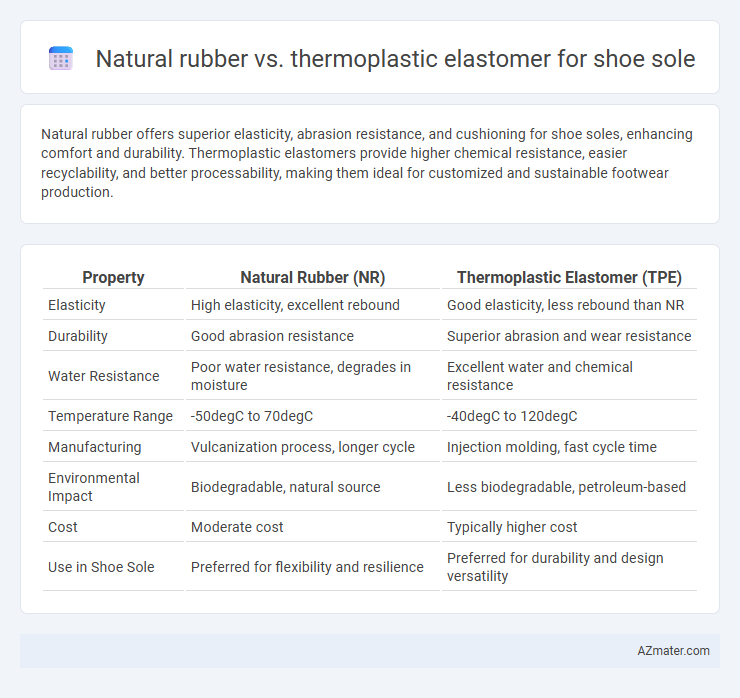Natural rubber offers superior elasticity, abrasion resistance, and cushioning for shoe soles, enhancing comfort and durability. Thermoplastic elastomers provide higher chemical resistance, easier recyclability, and better processability, making them ideal for customized and sustainable footwear production.
Table of Comparison
| Property | Natural Rubber (NR) | Thermoplastic Elastomer (TPE) |
|---|---|---|
| Elasticity | High elasticity, excellent rebound | Good elasticity, less rebound than NR |
| Durability | Good abrasion resistance | Superior abrasion and wear resistance |
| Water Resistance | Poor water resistance, degrades in moisture | Excellent water and chemical resistance |
| Temperature Range | -50degC to 70degC | -40degC to 120degC |
| Manufacturing | Vulcanization process, longer cycle | Injection molding, fast cycle time |
| Environmental Impact | Biodegradable, natural source | Less biodegradable, petroleum-based |
| Cost | Moderate cost | Typically higher cost |
| Use in Shoe Sole | Preferred for flexibility and resilience | Preferred for durability and design versatility |
Introduction to Shoe Sole Materials
Natural rubber offers excellent elasticity, abrasion resistance, and slip resistance, making it a traditional choice for durable shoe soles. Thermoplastic elastomers (TPE) combine the flexibility of rubber with the processability of plastics, enabling lightweight and cost-effective soles with good cushioning and wear resistance. The selection between natural rubber and TPE depends on performance requirements, manufacturing methods, and environmental considerations in shoe sole production.
Overview of Natural Rubber
Natural rubber is a highly elastic material derived from the latex sap of rubber trees, widely used in shoe soles due to its excellent flexibility, resilience, and superior abrasion resistance. It offers outstanding grip and shock absorption, making it ideal for footwear designed for outdoor and athletic activities. However, natural rubber can be susceptible to degradation by heat, UV exposure, and chemicals, which may affect shoe sole durability compared to synthetic alternatives like thermoplastic elastomers.
Overview of Thermoplastic Elastomer (TPE)
Thermoplastic elastomers (TPE) are highly versatile materials used in shoe soles, combining the elastic properties of rubber with the processing advantages of plastics. Unlike natural rubber, TPE offers enhanced durability, recyclability, and resistance to abrasion, chemicals, and environmental factors, making it ideal for high-performance footwear. The ability to be molded and reprocessed multiple times improves manufacturing efficiency and sustainability in shoe sole production.
Mechanical Properties Comparison
Natural rubber exhibits superior tensile strength and elasticity, providing enhanced durability and flexibility for shoe soles under repetitive stress. Thermoplastic elastomers (TPE) offer excellent abrasion resistance and resilience, with better compression set performance, ensuring long-lasting shape retention. While natural rubber provides greater tear resistance, TPEs deliver improved processability and lightweight properties, making them suitable for diverse footwear applications.
Durability and Wear Resistance
Natural rubber offers superior elasticity and excellent abrasion resistance, making it highly durable for shoe soles exposed to rough terrains. Thermoplastic elastomers (TPE) provide better resistance to environmental factors such as oils and chemicals, contributing to long-lasting wear in diverse conditions. While natural rubber excels in flexibility and resilience, TPE's enhanced wear resistance and customizable hardness create durable soles suited for specialized footwear applications.
Flexibility and Comfort Performance
Natural rubber offers superior flexibility and excellent cushioning, providing enhanced comfort by adapting to foot movements and reducing impact stress during walking or running. Thermoplastic elastomers (TPE) deliver consistent elasticity with lightweight properties, improving durability and providing moderate flexibility suitable for various shoe sole applications. The choice between natural rubber and TPE depends on the balance between maximum comfort through natural material elasticity and the wear resistance afforded by synthetic polymers.
Environmental Impact and Sustainability
Natural rubber, derived from Hevea brasiliensis trees, offers biodegradability and renewability, making it a more sustainable option for shoe soles compared to synthetic alternatives. Thermoplastic elastomers (TPEs), often petroleum-based, have longer lifecycles and are recyclable but pose challenges in biodegradability and reliance on fossil fuels. The environmental impact of natural rubber is generally lower due to carbon sequestration during tree growth, while TPEs contribute to microplastic pollution and require more energy-intensive production processes.
Cost Efficiency and Manufacturing Process
Natural rubber offers superior elasticity and abrasion resistance for shoe soles but involves higher material costs and longer vulcanization times in manufacturing. Thermoplastic elastomers (TPE) provide cost efficiency through faster processing using injection molding and easier recyclability, reducing overall production expenses. The choice depends on balancing performance requirements against budget constraints and production volume scalability.
Application Suitability in Footwear Types
Natural rubber offers superior elasticity, durability, and excellent grip, making it ideal for high-performance athletic shoes and outdoor footwear requiring strong traction and impact resistance. Thermoplastic elastomers (TPE) provide lightweight, flexible, and recyclable properties, suitable for casual and fashion footwear where comfort and customization are prioritized. The choice between natural rubber and TPE depends on specific footwear demands such as durability for sports versus flexibility and eco-friendliness for lifestyle shoes.
Conclusion: Choosing the Right Material for Shoe Soles
Natural rubber offers superior elasticity, abrasion resistance, and excellent grip, making it ideal for highly durable and flexible shoe soles used in demanding environments. Thermoplastic elastomers (TPE) provide lightweight, cost-effective, and recyclable alternatives with good flexibility and chemical resistance, suitable for casual or fashion footwear. Selecting the right material depends on balancing performance requirements, durability, and environmental impact specific to the shoe's intended use.

Infographic: Natural rubber vs Thermoplastic elastomer for Shoe sole
 azmater.com
azmater.com